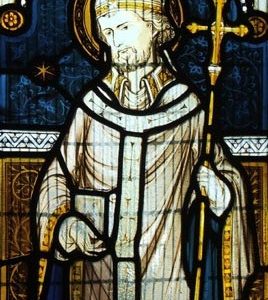The Scarlet Letter is Nathaniel Hawthorne’s best-known novel, and it must be placed very near the top of the canon of American literature, the list of works that any student of American culture ought to read. A masterpiece of the Romantic literary movement, it can be read as a historical-fictional account of the Puritan culture woven into the fabric of our nation. Within it, Hawthorne uses his characters to depict moral grappling with questions of freedom, integrity, and virtue; and to illustrate the tenuous balance between facing our sins, accepting God’s grace, and undertaking the actions of conversion that make a real difference in our lives.
Some basic knowledge of the novel’s plot is essential for a reader to understand and appreciate these moral lessons. A young, beautiful woman, Hester Prynne, has become a resident of the Puritan colony at Boston in the middle of the seventeenth century. She has been sent ahead of her husband, a physician and alchemist, who seeks to advance science, knowledge, and his career. The reader first witnesses Hester exiting from the local prison and onto the town scaffold, holding her new baby in her arms, to be subjected to scorn by the Puritan townspeople. Her husband arrives to town at this juncture, knowing quickly that she has committed adultery; and he vows revenge upon the man who has wronged both of them. It is not until nearly halfway through the novel that the reader discerns Reverend Arthur Dimmesdale, the town’s laudable minister, as the one who committed the sinful act with Hester and sired the child, named Pearl.
Hawthorne begins his commentary on freedom and integrity in the introductory chapter. There, he writes, “There are few uglier traits of human nature than this tendency…to grow cruel, merely because they possessed the power of inflicting harm.” Throughout the balance of the book, the author illustrates this ugly tendency through Hester’s estranged husband, Roger Chillingworth. As the narrative unfolds, he reveals the insidious nature of Satan’s work preying on human intellect and freedom as his psyche is dominated by envy, bitterness, and the desire for revenge. Specifically, he gains access to Arthur Dimmesdale under the pretense of acting as the minister’s physician and then admits his diabolical plan. Speaking of Dimmesdale, the physician exclaims:
In a pivotal scene later in the book, the reverend speaks of his nemesis, saying, “That old man’s revenge has been blacker than my sin. He has violated, in cold blood, the sanctity of a human heart” (Chapter XVII).
One of this novel’s greatest qualities is that it serves as an open window for readers to examine their own consciences. By witnessing the downward spiral of Chillingworth, who seems possessed, readers might seek more effective ways to root out envy and bitterness from their own lives, along with any lingering desire for revenge.
The subject of Chillingworth’s ire, Reverend Dimmesdale, also offers the reader a window to consider the qualities of integrity. Throughout the novel, the adulterous minister refuses several opportunities to admit his sin and be recognized as Pearl’s father. Clearly, he is afraid of having his name besmirched and being subjected to public consternation. Near the end of the novel, Hawthorne paints the minister’s introspection about his reasons for doing so:
As the reader turns page after page, he witnesses Dimmesdale’s physical diminution, which reveals his deteriorating spiritual condition. Ultimately, this trajectory causes the reader to reflect on his own spiritual condition, perhaps asking, “Am I a man of courage and integrity, or am I persuaded more by social standing?”
Dimmesdale’s paramour, Hester Prynne, also provides acute lessons in freedom, integrity, and virtue. Hawthorne describes Hester as “a figure of perfect elegance…characterized by a certain state and dignity,” but also surrounded by the “misfortune and ignominy” that came with having been found out as an adulteress (Chapter II). As the narrative develops, the reader sees all the more that her character reveals pride mixed with humility, sinful humanity mixed with grace and beauty.
For most of the novel, Hawthorne illustrates Hester’s spiritual development by commenting on the deep and authentic freedom available to her, but which she pridefully refuses. After the societal condemnation she receives as punishment for her sin, she develops a certain pragmatism toward transformation. Seven years after her subjection to public shame, she had changed some, but not completely:
The author underscores this very idea several chapters later when he writes, “Shame, Despair, Solitude! These had been her teachers,—stern and wild ones,—and they had made her strong, but taught her much amiss.” In the same portion of the book, Hawthorne writes that Prynne was “determined to redeem her error” (Chapter XVIII). In Hester’s character, particularly, the reader is offered ample opportunity to meditate on themes of sin, grace, freedom, and conversion, as well as the interplay between them. By the end of the narrative, the reader can learn the valuable lesson that acknowledging sin and accepting God’s mercy work in tandem to lead us to a freedom in which we can cultivate something more than fragile integrity and false virtue.
Finally, Hawthorne provides memorable lessons on virtue as the deepest potential for our fallen human nature. Throughout the novel, such lessons are clearest and most acute in the character of Pearl. The author writes Hester’s thoughts about how her daughter’s character might develop, since Pearl is the product of an adulterous act between her mother and the Reverend Dimmesdale. “In giving her existence,” Hester thinks, “a great law had been broken; and the result was a being whose elements were perhaps beautiful and brilliant, but all in disorder; or with an order peculiar to themselves, amidst which the point of variety and arrangement was difficult or impossible to be discovered” (Chapter VI).
As the novel progresses, the powerful potential of the young girl in two directions becomes all the more apparent.
Pearl’s character provides a stupendous icon of the enigma of fallen humanity. Each of us is born with the wound of original sin, which we have inherited from our first parents, and which causes us to have an “acrid and disagreeable” disposition toward all kinds of sinful attitudes and actions. It is what causes us to make the choices that putrefy the world. Yet, because we are created in the image of God, with intellect and will, we have the potential for greatness and beauty. Every human person has the potential for grave depravity and grave nobility.
The Scarlet Letter offers each reader an opportunity to reflect at length on the ways that he or she has fostered the gift of freedom, moving toward integrity and virtue or enslaving oneself to the attractive facades of sin. Each of us must ask if the choices we make cultivate a habitual firmness of body and spirit, or if we have given in to the work of Satan who tears apart our bodies, minds, and spirits. How can we fortify ourselves so that the “steadfast principles” of virtue emerge from our actions, instead of the poison of pride, revenge, bitterness, or cowardice? These seem to be the primary questions with which a great American author wants us to wrestle.
Image by William Alexander from Pixabay
Hawthorne, N. (1986). The Scarlet Letter. Bantam.










